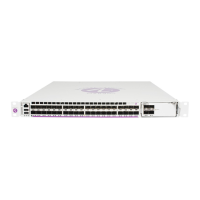Port Features
Page 56 7750 SR Interface Configuration Guide
The following BFD support is provided:
• BFD is supported on an IP interface configured over a FR SAP with e2e fragmentation
enabled.
• BFD is supported on an IP interface configured over a FR SAP on a port or channel with
UNI/NNI fragmentation enabled.
• BFD is not supported on an FR SAP configured on an MLFR bundle.
The following mirroring support is provided:
• Port mirroring and FR SAP mirroring on an MLFR bundle.
• IP mirroring for an FR SAP on an MLFR bundle.
• A mirror source can be an MLFR bundle or a FR SAP on an FR bundle.
• Mirror destinations must be FR SAPs and must not be part of an APS group or an MLFR
bundle.
Multilink Point-to-Point Protocol (MLPPP)
Multilink point-to-point protocol is defined in the IETF RFC 1990, The PPP Multilink Protocol
(MP), and provides a way to distribute data across multiple links within an MLPPP bundle to
achieve high bandwidth. MLPPP allows for a single frame to be fragmented and transmitted across
multiple links. This allows for lower latency and also allows for a higher maximum receive unit
(MRU).
MP is negotiated during the initial LCP option negotiations of a standard PPP session. A router
indicates to its peer that it is willing to perform MLPPP by sending the MP option as part of the
initial LCP option negotiation. This negotiation indicates the following:
1. The system offering the option is capable of combining multiple physical links into one
logical link;
2. The system is capable of receiving upper layer protocol data units (PDU) fragmented
using the MP header and reassembling the fragments back into the original PDU for
processing;
3. The system is capable of receiving PDUs of size N octets where N is specified as part of
the option even if N is larger than the maximum receive unit (MRU) for a single physical
link.
Once MLPPP has been successfully negotiated, the sending system is free to send PDUs
encapsulated and/or fragmented with the MP header.
MP introduces a new protocol type with a protocol ID (PID) of Ox003d. Figure 4 and Figure 5
show the MLPPP fragment frame structure. Framing to indicate the beginning and end of the
